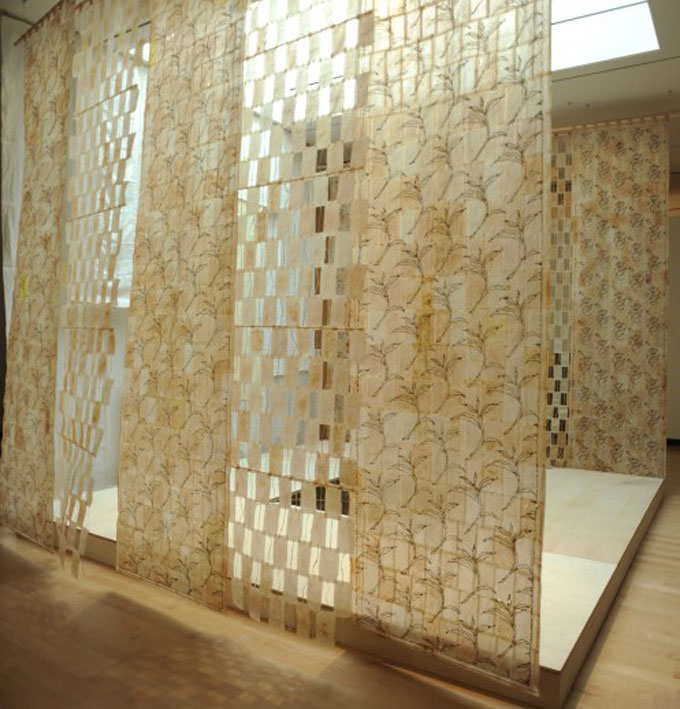An Installation by Judy Olson Gregory at Burchfield Penney
by Jack Foran

Tea Time
You are on a journey filled with opportunity. Will you allow for randomness in your life? Are you planting seeds of promise? What do you hear in the silence?
Some tea questions and a proposition posed by Judy Olson Gregory’s installation all about tea at the Burchfield Penney Art Center.
To discover them—these questions and proposition and others of the sort—you have to remove your shoes and enter a little teahouse with central open pit—like a fire pit, but containing not fire but a large quantity of loose tea—leafy, powdery—the equivalent of the content of a few thousand tea bags—that with an available long-handled paddle you are encouraged to gently brush aside to reveal messages—the questions and propositions—inscribed on the subsurface under the tea. A little like the messages my grandmother read in the leaves left in the bottom of her cup after drinking her tea—teabags may have been something of a novelty then, but in any case she would have considered them a luxury, and always used loose tea—that she would never say just what the messages were. But whatever she was able to read and interpret, ultimately, I think, would have been in the nature of the existential questions and propositions discoverable under the tea mass in the Olson Gregory installation.
For nothing trivial about tea. So the installation considers existential questions on the one hand, and the much troubled history of tea commerce on the other. How in the nineteenth century the British passion for Chinese tea, as well as other Chinese goods, such as silks and porcelain, because the self-sufficient Chinese had no similar craving for English goods, such as woolens, resulted in a huge outflow of British silver to China to purchase the Chinese products. The British solution to their monetary problem was to introduce opium into the Chinese world, with predictable disastrous sociological as well as political results. A series of wars over the tea and opium matter opened China to world trade, at the point of the British sword. From personal philosophical questions to global sociopolitical moral questions.
The little secular temple teahouse walls consist of a variety of fabric hangings. Lace cloth, rice paper figured with floral designs of tea leaves and opium poppies, and screens of used and dried—so tea-stained—tea bag tissue. Shades—literally—of amber, umber, ecru.
Another work, called Journey Coat: Chance and Choice, includes a tea-stained handmade paper tunic-type garment with lining of myriad used and dried tea bags, with tags attached—but not the original brand-name tags but little maps, evocative possibly of where the particular cup or glass of tea was consumed—and a wicker tea chest full of similar used and dried tea bags, also with tag maps. Maybe where the tea was headed in trade, but never got there. But a message about the universality and generality of the tea experience, the experience as communal worldwide.
A tea-stained—of course—note in the tea chest provides directions on the proper way to make a cup of tea and how to read tea leaves. First, make a wish or think of a question, it recommends. Then, “leave about a teaspoon of liquid in the cup with the leaves. Hold the cup in the left hand and swirl three times to the left. Gently turn the cup upside down in the saucer to drain. Turn the cup right side up and look for the first pattern. This will be the response to the wish or question.” And lists a number of possible lea leaves images and what they portend. An anchor signals a voyage. An arrow means bad news. A cat, good luck. A dog, good friends. A crescent moon, changes. A knife, arguments. A fish, very good fortune. A heart, of course, love. A rainbow, future good luck. And a ring, marriage.
Another sculptural work, called Stir, is a circular array of similar enigmatic forms with wide end and tapering at the other end to a kind of curlicue stem. Something between the teahouse paddles and ginkgo leaves.
The Judy Olson Gregory installation is called Taking Tea. It remains on view through February 22.
blog comments powered by Disqus|
Issue Navigation> Issue Index > v14n2 (Week of Thursday, January 15) > An Installation by Judy Olson Gregory at Burchfield Penney This Week's Issue • Artvoice Daily • Artvoice TV • Events Calendar • Classifieds |









 Current Issue
Current Issue